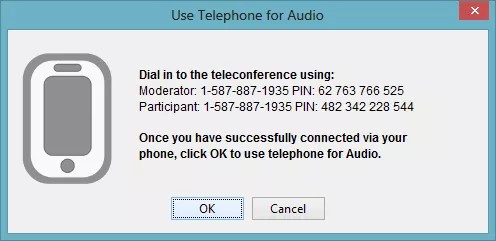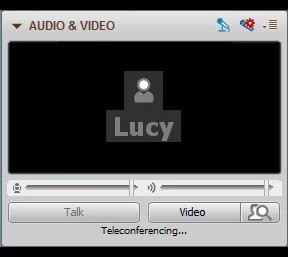If offered by your institution, you can use the telephony feature to communicate with other users. As a teleconference user, you can use all Blackboard Collaborate features and communicate with users not connected to the teleconference.
To incorporate a teleconference into your session, a bridge between the teleconference and the Blackboard Collaborate session must be established. Although this bridge is not a person, the bridge appears in the participant list as Teleconference.
You must place all telephony users in the same Breakout Room as the teleconference bridge to properly route their communications to the session.
Mobile device users cannot use a teleconference for audio communications in a session.
Two Types of Teleconferencing Services
You can use two types of teleconferencing services for Blackboard Collaborate:
- Integrated Telephony: With Integrated Telephony, customers do not need their own teleconference providers. The teleconference service is provided by Blackboard Collaborate. Teleconference phone numbers and PINs are automatically generated during session creation. Anyone can dial into the session and initiate the connection between the session and the teleconference bridge.
Integrated Telephony only allows for 25 simultaneous connections.
- Third Party Provider Telephony: With Third Party Provider Telephony, customers must use their own teleconference providers. The teleconference bridge is established when you configure the teleconference connection information and connect the session to the teleconference. As the moderator, you establish and maintain the connection to the teleconference. You also manage the telephony users within the participants list. You may communicate in the session using either microphone and speakers (VoIP) or the telephone (telephony).
Teleconference Bridge Chairperson
With some teleconference providers, a teleconference chairperson must join the teleconference before other participants can join. Participants may hear a message such as "All participants will be on hold until the chairperson has joined the teleconference."
The teleconference chairperson may also need to manage the teleconference and its participants with call controls issued on a touch-tone telephone.
- Teleconference Bridge as Teleconference Chairperson: If the only purpose of a chairperson is to enable others to join the teleconference, you can use the teleconference bridge to simulate this role. You need to program the teleconference bridge with the teleconference chairperson PIN.
- Moderator as Teleconference Chairperson: If a chairperson is needs to manage the teleconference and its participants, the chairperson must be an actual person. If moderators are familiar with the management of the teleconference service, they can take on this role. A moderator must use telephony for audio communications and use the touch-tone keypad on a telephone to connect to the teleconference. Except during the initial connection phase, you cannot send call control codes with the teleconference bridge.
Activity Indicators
In the participants list, you can monitor the state of audio and telephony activity through indicators described in the following table.
| Activity Indicator | Description |
|---|---|
| User enabled the microphone and is using VoIP for audio. | |
| User is connected to the teleconference. | |
| User is connected to the teleconference, but the moderator revoked the user's audio permission. Therefore, the teleconference is muted. | |
| User is using telephony mode for audio communications and using the phone for audio. | |
| User is using telephony mode for audio communications and using the phone for audio, but the teleconference is muted. |
How to Join a Teleconference
All sessions must be connected to a teleconference.
You can join a teleconference if the telephone icon appears in the title bar of the Audio & Video panel.
- Click the Use Telephone for Audio icon.
The Use Telephone for Audio window opens with the phone number and PIN information.
- On your telephone, dial the teleconference telephone number.
- If required, provide the PIN as instructed by the teleconference. If your teleconference prompts you to provide your conference number followed by the pound key (#), enter your PIN as the "conference number."
- When you are successfully connected to the teleconference, you will hear a recorded message signaling you have joined. With integrated telephony, you hear a chime and "The web session has joined the teleconference."
- Click OK to dismiss the Use Telephone for Audio window.
When you are connected to the teleconference, the word Teleconferencing... appears at the bottom of the panel. The Use Telephone for Audio icon in the title bar changes to the Use Microphone and Speakers for Audio icon.
When you use the telephony feature, your Talk function is disabled.
You also see the teleconference activity indicator next to your name in the participants list.
How to Leave a Teleconference
You can leave a teleconference and use your microphone and speakers for audio.
- Click Use Microphone and Speakers for Audio in the title bar.
- In the Use Microphone & Speakers for Audio window, click OK to leave the teleconference.
- Hang up your phone.
Configure Third Party Provider Teleconference
The session creator can configure the teleconference connection information for third party providers. If not, you must provide the information before you can connect a session to a teleconference.
More on configuring third party teleconference
Connect Sessions to the Teleconference
After you configure the connection information, you must establish the bridge (connection) between the session and the teleconference.









